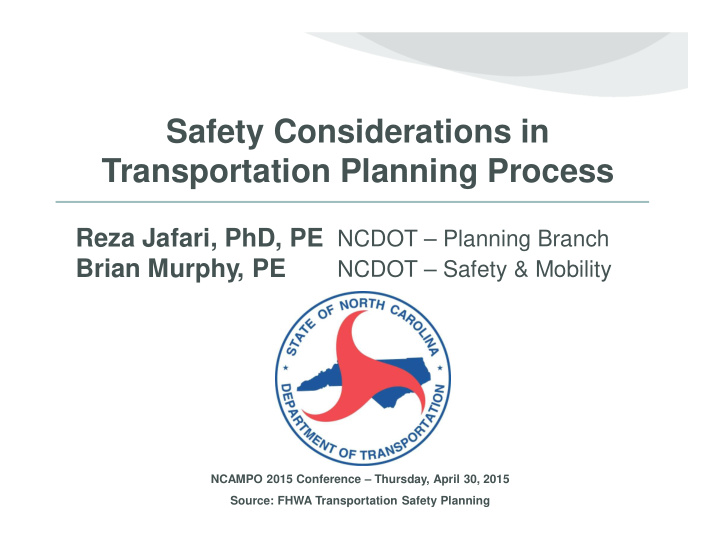



Safety Considerations in Transportation Planning Process Reza Jafari, PhD, PE NCDOT – Planning Branch Brian Murphy, PE NCDOT – Safety & Mobility NCAMPO 2015 Conference – Thursday, April 30, 2015 Source: FHWA Transportation Safety Planning
Transportation Safety Planning Reducing fatalities and serious injuries by supporting comprehensive, system-wide, multimodal, and proactive process that… Integrates safety into surface transportation decision-making
Safety-Related Features of MAP-21 Metropolitan & Statewide plans must: • Integrate performance goals, measures and targets. • Report on the overall effectiveness of performance- based planning. Highway Safety Improvement Plan (HSIP) • Increases size of existing HSIP. • Requires measures establishment and setting targets for number and rate of serious injuries & fatalities.
The Safety 4E Approach
Integrating Safety • Multidisciplinary • Multimodal • System-wide • Collaborative • Proactive
Performance-Based Transportation Planning Process
Integrating Safety into Planning Process Engage community and safety stakeholders in initial planning process Identify safety as a major measurable organizational goal Identify existing safety issues in the system & set targets to correct them
Integrating Safety into Planning Process - Collect and analyze safety data - Use data to find sites for safety treatments Use safety policies from other planning documents as a guide for LRTP/MTP Include safety-related scoring in LRTP/MTP to establish safety as a factor in project selection
Integrating Safety into Planning Process Design standalone safety projects Integrate safety elements into other TIP projects
Integrating Safety into Planning Process Constantly revise strategies to meet safety goals and objectives Periodically evaluate progress toward safety performance measures Evaluate successes in safety initiatives
Safety Planning at Federal Level • Guide progress of performance-based planning through education and training. • Proactively promote, monitor, educate and communicate ways for State DOTs and planning organizations to integrate safety in planning.
Safety Planning at State Level • Performance-based planning requires greater coordination across agencies and between functional areas (i.e., safety, congestion, asset condition, etc.). • Use crash and GIS data to identify safety concerns and assist improving engineering safety strategies. • Work with enforcement at corridor-level. • Integrate safety goals, objectives, and strategies in transportation planning process.
Safety Planning at MPO Level • Help educate local elected officials and public. • Demonstrate the economic impact of improving transportation safety. • Identify low-cost safety improvements (start small) • Work with private/public entities for funding. • Pursue the 4E approach to improve safety.
Safety Planning at RPO Level • Participate with MPOs; integrate rural safety concerns into the planning process. • Align with State Plans to capture state funding for safety. • Educate local elected officials and public. • Demonstrate economic impact of safety improvements. • Leverage local funds. • Identify low-cost safety improvements. • Improve availability and accuracy of safety data.
Safety Planning for Elected & Appointed Officials • Laws passed by legislatures impact transportation safety significantly (i.e., helmet laws). • Judicial decisions in traffic safety cases. • Encourage local planners to prioritize for safety. • Set-aside funding to advance safety projects. • Promote the importance of safety.
Conclusion • Work collaboratively to identify safety integration opportunities. • Leverage planning process to impact safety. • Engage transportation planners & committees. • Build consistency between long range plans and safety plans. • Use data and analysis to benchmark and measure safety issues.
Recommend
More recommend